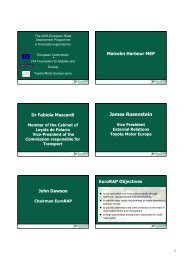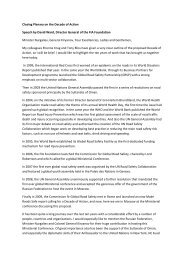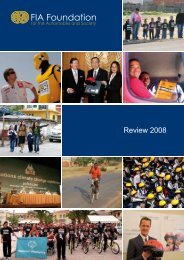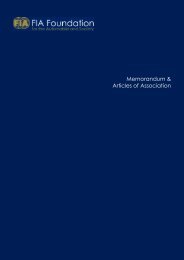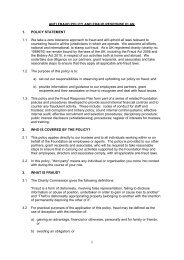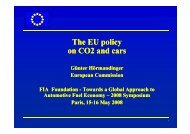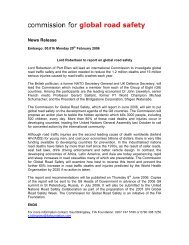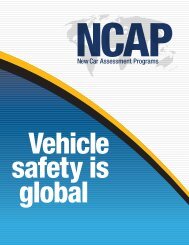FIA Foundation
FIA Foundation
FIA Foundation
You also want an ePaper? Increase the reach of your titles
YUMPU automatically turns print PDFs into web optimized ePapers that Google loves.
THE: I'ERA4A.'.£I'·rr ,\oilSSIQNOF'T11£ m:runuc OF N.A-\.tiRli\TO THE lINlITU NA nox~I June 2015Excdlency.We are addressing you in our capacity as Co-Chairs of the Ad Hoc Working Group onthe revitalization of the work of the General Assembly (AHWG) and \~ish to thank alldelegations for (heir active participation in the five meetings of the Ad Hoc Working Groupheld since March 2015.In tbe next stage of our wDrk, we will engage in infonna! consultations on the draftrew!ution on the revitalization of the work of the General Assembly, which is to be adoptedas part of the report of the Ad Hoc Working Group. In this regard. and after consulting withthe President of the General Assembly, we have the pleasure 10 enclose herewith the dmftresolu.tion based on discussions we had in the previous meetings.Delegations are welcome to send their comments andfor proposals on this draft resolutionuntil 8 .lIme 2015 to the following e-mail addresses: mslmQIlic(a'mven.hr andomunts:ierq)vahoo.col!1.l11e first intormal meeting on the draft resolutiDn will be held on Wednesday, 10 June2015. The venue will he announced in the Journal. in a timdy manner.We are looking forward to your active participation in discussions on the proposed draftresolutioll.Please accept Excellency, the assurances of Ollr highest consideration.Vladimir OrobnjakAmbassador and PermanentRepres;;ntativc of CroatiaWilfried l. EmvulaAmbassador and PcmmnentRepresentative of NamibiaTo: All Perm""ent Representatives and Pcr",.nentObscners to the United Nations, New York
Introduction - Rosario Alessi, ChairmanI am delighted to introduce the 2004 Review of the <strong>FIA</strong> <strong>Foundation</strong> for theAutomobile & Society.This Review showcases some of the recent activities of the <strong>FIA</strong> <strong>Foundation</strong>. Since January 2002, when the<strong>Foundation</strong> began its work, we have been extremely active in promoting road safety, supporting environmentalresearch and tackling some of the mobility issues relating to the automobile. The breadth of our work isdemonstrated in this review, and I would like to pay tribute to my fellow trustees and the many organisationsthat we have worked with around the world to achieve our charitable objectives.I hope you find this Review a useful window on the work of the <strong>FIA</strong> <strong>Foundation</strong>.Rosario AlessiChairman<strong>FIA</strong> <strong>Foundation</strong>01
Road safety campaigner conducts seat belt survey, Costa Rica, August 2004
Overview - David Ward, Director GeneralFrom seat belt advocacy in CostaRica and carbon sequestration inMexico to road design safety assessmentsin Europe and car crash testsin Australia, Review 2004 reflects theglobal scope of the <strong>FIA</strong> <strong>Foundation</strong>’swork.In a very short period of time, the <strong>FIA</strong> <strong>Foundation</strong> hasestablished a leading role in promoting road safetyaround the world, both as a source of charitablegrants and as an active partner in road safetyinitiatives. To d a y, projects supported by the <strong>FIA</strong><strong>Foundation</strong> are helping to improve road safety andeducating and empowering people in every region ofthe world.The <strong>FIA</strong> <strong>Foundation</strong> has worked hard to raise theprofile of global road safety, particularly in thedeveloping world. Our support for the World HealthOrganisation’s (WHO) strategy for road traffic injuryprevention led directly to the first global awarenessday on road safety, World Health Day 2004, andcontributed to the first United Nations GeneralAssembly debate and resolution on this vital issue. Iam particularly pleased that the <strong>FIA</strong> <strong>Foundation</strong>’se fforts have been recognised by the SecretaryGeneral of the United Nations, Kofi Annan.Research into public policy issues relating to theautomobile’s interaction with society, and initiativesthat improve the environmental performance of thecar, are important aspects of our activities. The<strong>Foundation</strong>’s secretariat participate regularly in theUN working groups on road traffic safety and vehicletechnical standards in Geneva, and monitor policyissues at the OECD and in the UN’s climate changebodies. Working groups on public policy enable the<strong>Foundation</strong> to engage with international automobileclubs, and in 2004 we held our first InternationalPolicy Forum, focused on road safety for children.Motor sport safety has also been an integral part ofthe <strong>FIA</strong> <strong>Foundation</strong>’s work, and we have been able tosupport potentially lifesaving research at the cuttingedge of motor sport technology. The <strong>FIA</strong> <strong>Foundation</strong>has also recently helped to found the independent<strong>FIA</strong> Institute for Motor Sport Safety, which willquickly establish itself as an international centre ofexcellence for safety-related research in motor sport.More details on the projects and issues highlighted inReview 2004, and information on the <strong>FIA</strong><strong>Foundation</strong>’s other activities, can be found on ourwebsite www.fiafoundation.comDavid WardDirector General<strong>FIA</strong> <strong>Foundation</strong>03
‘By bringing the whole society together youcan contain this epidemic’UN Secretary General Kofi A n n a ntalks to the <strong>FIA</strong> <strong>Foundation</strong> about theneed for action on global road trafficinjuries.Question: Will you talk about your concern about theimpact that road accidents are having on the worldcommunity?Kofi Annan: I think it is a major problem, but I am notsure that people are aware that annually 1.2 millionpeople are killed by road accidents and between 20and 50 million more are disabled by them. I think thisis a major problem that we all need to focus on.Q: Why do you feel the problem is so low on theinternational agenda and doesn’t receive theattention that those figures suggest it should?KA: These accidents often occur one by one and it isa personal and individual tragedy. I’m not sure ifpeople are aware of the kind of numbers involvedand if they were to look at it in those terms it will havean impact and it will raise awareness. Perhaps weshouldn’t use the word ‘accident’ and should reallytalk about crashes, collisions, major disasters,because if it is an accident people tend to befatalistic about it: “What could I have done. Anaccident is an accident.” We should perhaps evenchange our language and of course education.
Q: Road traffic injuries also have a disproportionateeffect in the developing world, I wonder if you wouldaddress both the terrible personal tragedies toindividuals and also the major economic impact?KA: Ninety per cent of the people killed are betweenthe ages of fifteen and forty, which are the mostproductive years in most countries. Apart from thepersonal tragedies for the families it has a realeconomic impact and it is also affecting childrendisproportionately. About 96% of the 180,000children killed a year are in the South. Quite apartfrom that we need to take steps to protect innocentpeople who use these roads who get killed, it’susually the bicycle riders, motor-bicycle riders,mopeds or pedestrians. So we have to takeprecautionary measures to ensure that they can usethe roads without being at risk.Q: What do you think can be done to raise this on thepolitical agenda? What needs to be done with keydecision makers and politicians?KA: I think first of all they need to recognize that thereis a problem at the national level and also tounderstand that it is not an issue for the Ministry ofTransport alone and it does affect the Ministry ofFinance, the Ministry of Health, Education, Justiceand the police. They also should come up with anational plan to declare road casualties andgovernments have done this. France did this veryrecently with President Chirac himself leading theprocess and I would urge other leaders to see this asa major problem and to play their leadership role.I believe at the international level we need to docertain things better. Today we don’t have a singleagency that has a responsibility for road safety.Perhaps we need to identify one individual unit thatwill come up with an action plan which will be usefulnot only at an international level but for individualnational governments where they don’t have thecapacity or don’t know how to develop one on theirown.I think the UN has to get governments toacknowledge that this is a real problem. I think theUN has a voice, it has a convenient power and I thinkthis is an area where we should do much more. Iintend to work on this with the World HealthOrganization and the other agencies. You know twicea year we meet, all the heads of the UN agencies,and this is an issue that I will raise with them to seehow collectively we can pool our efforts to have animpact.Q: Can I ask you to talk about the issue of involvingthe private sector and civil society and the need foragencies and organisations to work together?KA: I believe firmly in working in partnership. Let mestart with the private sector and the carmanufacturers, I think they have a role to play. Theyhave a role to play in ensuring that cars that do notmeet standards in the North should not be sold in theSouth. The same safety requirements are needed inthe South. I think apart from what governments cando, NGOs and civil organizations can becomeinvolved in the whole education campaign, ineducating people not to just jump behind the wheeland drive because it is much more likely to lead to acrash. I think by bringing the whole society togetherto participate, you can take much faster strides incontaining this epidemic because it is likely to go onunless we take effective action.Q: The <strong>FIA</strong> <strong>Foundation</strong> in particular is working withgovernments to highlight the use of seatbelts as amajor thrust of their campaign. I wonder if you wereable to acknowledge the work that the <strong>FIA</strong><strong>Foundation</strong> and governments are doing together onthis crucial issue?KA: I support that. I think that we should press on, onindividuals and governments, to introduce legislationthat will require that cars should have seatbelts andthat people should wear them, you may even gofurther and talk about seats for children, since quite alot of the crashes lead to the deaths of young people.So I do support that effort and if there is anything thatI can personally do to support them, I will be preparedto do that.I think we must be grateful to the <strong>FIA</strong> <strong>Foundation</strong> forits role in the initiative it has taken and helping uscontain and combat this problem, and I would want tobe able to do whatever I can to support their effortand I also applaud their leadership and the initiativethey have taken here.Q: Looking to the future and the serious implicationsof growing car ownership increasing the urgency ofthis issue. Will you address the dangers of what willhappen unless action is taken?KA: You have the question of the number of cars onthe road and the ways the roads are constructed,some, particularly in the developing world,sometimes without any safety consideration. So youneed to ensure that cars have the safetyrequirements, the proper brakes, and are properlyinspected and also to ensure that the roads are builtwith safety in mind. Because if they do not do that thekinds of figures that we see now could increase byabout sixty percent and nobody would want to seethat. And therefore we need to really take thesesafety measures…with education, to ensure that wereduce crashes and collisions.05
On the road safety campaign trail with the <strong>FIA</strong><strong>Foundation</strong>New York, 14th April 2004. At the imposing United Nations headquarters,towering over the East River in Manhattan, history is being made.Transport and health ministers from across the world have gathered in theUnited Nations General Assembly to approve the first ever UN resolutionmandating action on road traffic injuries. By the end of the day, the WorldHealth Organisation has been given the role of coordinating a response toroad safety by UN institutions and the international community has takenits first step towards combating rising road deaths in the developing world.For the <strong>FIA</strong> <strong>Foundation</strong>, it is the culmination of almost two years of roadsafety advocacy, beginning on the other side of the world…Geneva, August 2002. In a meeting room at the WorldHealth Organisation’s headquarters in Geneva a roadsafety revolution is planned. Funding from the <strong>FIA</strong><strong>Foundation</strong> has enabled WHO’s injury prevention teamto dedicate staff and time to road traffic injuries. Now UNagencies, injury specialists and road safety NGOs,including the <strong>FIA</strong> <strong>Foundation</strong>, are working out a strategyto promote road safety on an unprecedented scale,through a national awareness day and a major report byWHO and the World Bank.Global road traffic injuries: thefacts1.2 million people worldwide areestimated to be killed each year onthe roads – more than 3000 peopleevery day;London, November 2002. The <strong>FIA</strong> <strong>Foundation</strong> participatesin the first (phone conference) meeting of theGlobal Road Safety Steering Committee. Arising fromdiscussions during the WHO meeting, this informal coalitionof UN agencies (WHO, UNICEF, World Bank, UNDPand UNDESA) and NGOs (the <strong>FIA</strong> <strong>Foundation</strong>, GlobalRoad Safety Partnership, Bone & Joint Decade,Association for Safe International Road Travel and TaskForce for Child Survival & Development) has one objective:to raise the political profile of road traffic injuries inorder to secure greater coordination and funds for roadsafety from the international community.50 million people worldwide areestimated to be injured in roadcrashes each year;The global financial cost of roadtraffic injuries is US$ 518 billioneach year;London, February 2003. ‘Sharing Responsibility for Safer Roads’ is the title of the<strong>FIA</strong> <strong>Foundation</strong>’s high level conference on global road safety, held at WhitehallPalace. Speakers include <strong>FIA</strong> President Max Mosley, UK Transport SecretaryAlistair Darling and WHO Director General, Gro Harlem Brundtland, whoannounces that WHO’s annual World Health Day will focus on road safety in 2004.Leading officials from the World Bank, WHO, European Commission and OECDdebate the need for coordinated international action on road traffic injuries. Alsoamong the speakers invited by the <strong>FIA</strong> <strong>Foundation</strong> is a leading advocate for roadsafety at the UN, the UN Permanent Representative for Oman, Fuad Mubarak AlHinai.
Paris, April 2004. French President Jacques Chirac launchesWorld Health Day 2004, with the theme ‘road safety is no accident’as a major <strong>FIA</strong> <strong>Foundation</strong> – funded report detailing theextent of the global road traffic injury crisis is published by WHOand the World Bank. The <strong>FIA</strong> <strong>Foundation</strong> participates in the officiallaunch event in Paris, and in events in London, Brusselsand Dublin, while automobile clubs around the world markWorld Health Day with campaigns and publicity launches. Alleyes turn to New York for the UN General Assembly debate.Geneva, February 2004. The <strong>FIA</strong> <strong>Foundation</strong> tables asecond paper at the UNECE proposing that the UNECEworking party on road traffic safety should, together withother regional UN commissions, become lead agency onroad safety issues within the UN system. A draft resolutionon the <strong>FIA</strong> <strong>Foundation</strong>’s proposal is circulated tomember governments for discussion and amendment inadvance of the UN General Assembly vote.The cost to low and middle incomecountries is US$ 65 billion, morethan all incoming development aid.By 2020, unless action is taken,road traffic injuries are predicted torise overall by about 65%;Low and middle income countriesaccount for more than 80% of globaldeaths from road traffic crashes.New York, November 2003. A second UN resolution,tabled by Ambassador Al Hinai and supported by thesteering committee, is approved without a vote at the UNGeneral Assembly. The resolution calls for a debate anda substantive resolution to be voted in April 2004, andurges UN support for World Health Day 2004.Geneva, July 2003. A policy paper is tabled by the <strong>FIA</strong><strong>Foundation</strong> at a meeting of the United Nations EconomicCommission for Europe (UNECE) Working Party on roadtraffic safety. The paper calls for a lead UN agency tocoordinate road safety interventions.New York, June 2003. Diplomats representing more thansixty countries attend a technical briefing on global roadsafety, organised by Ambassador Al Hinai and the globalroad safety steering committee. The <strong>FIA</strong> <strong>Foundation</strong>makes a presentation at the event. The meeting followssuccess by Al Hinai in tabling a resolution on the globalroad safety crisis in May 2003, requesting a report on theUN approach to road safety from the UN SecretaryGeneral Kofi Annan.
For love...use your seatbelt‘In Costa Rica we were very clear on theproblem. We decided to face it and solve it’Karla Gonzalez, Vice Minister for TransportationDrive through San Jose today and you will see police officers givingdrivers tickets – and advice – if they are not wearing their seat belt.You may think such police activity is not unusual, but until thesummer of 2004 it was impossible, because Costa Rica had no seatbelt law, and so the police were powerless to prevent motoristsdriving – and dying – unbelted.In 1997 a libertarian political movement succeeded in overturningCosta Rica’s seat belt law on the grounds that it was anunconstitutional breach of the freedom of the individual. Roadtraffic fatalities subsequently rose by 50%. Commenting on thesituation, Carlos Macaya, President, Automobile Club of CostaRica, said: ‘Costa Rica desperately needed a new seat belt law’.In August 2003 Costa Rica’s road safety council, including thepolice, government and the Automobile Club of Costa Rica, backedby the <strong>FIA</strong> <strong>Foundation</strong>, launched a major awareness campaign topromote seat belt use. At the same time the government introducednew seat belt legislation in the Costa Rican parliament.‘We have for the first time a good campaign which can convincepeople to wear a seat belt’. – Ignacio Sánchez, Director General,Traffic PoliceThe campaign’s message, with the slogan ‘For love - use your seatbelt’ was broadcast on the TV and radio; displayed on roadsidesigns and billboards; and printed on thousands of leaflets handedout by police officers and volunteers. A seat belt crashdemonstrator, provided by the <strong>FIA</strong> <strong>Foundation</strong>, toured the country.The campaign generated massive interest in the Costa Ricanmedia.In Parliament the debate raged until, in a late night vote just beforeChristmas, legislators approved a new bill to reintroducemandatory seat belt use. Still the battle was not over. Opponentsreferred the new law back to the Constitutional Court for anotheropinion. The Court’s opinion, that seat belt use for adults could becompulsory in front seats but not in the rear, was decisively rejectedby the parliament. New seat belt legislation was published inCosta Rica’s Official Journal, La Gaceta, on 5th May 2004, therebycoming into force.Within hours the police were on the streets enforcing the new seatbelt rules.09
Design for lifeIt’s a warm June morning in Prague. Shoppers,tourists and office workers pause to peer atbuckled metal and twisted shapes on display inWenceslas Square.But it’s not a piece of modern art they are admiring. The EuroNCAP road show is in town.The latest car crash test results from the European New CarAssessment Programme have just been announced at aninternational press conference in a nearby hotel, and now the carsare on public view. Eight of the twelve cars – including Toyota’shybrid Prius and the new VW Golf - have achieved the covetedfive stars for occupant protection in frontal and side impact crashtests. Child occupant protection and pedestrian protectionperformance are also measured.These results matter. For consumers the Euro NCAP rating a carreceives is of vital importance in deciding what car to choose. Cardealers know that the star rating can make or break a sale. Carcompanies, such as Renault, have spent millions on advertisingcampaigns to promote their good Euro NCAP results.These results matter because Euro NCAP ratings save lives. TheEuropean Commission has estimated that improved car design asa direct result of the <strong>FIA</strong> <strong>Foundation</strong> funded programme haspotentially saved 2000 lives a year in the fifteen countries of thepre-enlargement EU and that each star awarded to a car by EuroNCAP can be associated with a reduction of almost 10% in fatalaccident risk to occupants.In Australia, where the <strong>FIA</strong> <strong>Foundation</strong> also funds sister crash testprogramme ANCAP, the ratings scores are equally influential.ANCAP star ratings are featured in the car reviews of majormotoring magazines and, again, five star results get quoted in caradvertising.But five star cars need five star roads. A third consumerinformation programme funded by the <strong>FIA</strong> <strong>Foundation</strong> promotessafer highway design and publishes ‘risk maps’ to inform motoristsof the location of dangerous roads. The European RoadAssessment Programme (Euro RAP) has developed designprotocols and identified the types of roads and junctions whereserious crashes occur.Already active in several European countries, the roadassessment programme has gone international in 2004, with pilotprojects in the US and Australia. The <strong>FIA</strong> <strong>Foundation</strong>’s commitmentto informing – and empowering – consumers about roadsafety is global in design.11
Cleaner cars and fuelsEighty-five per cent of cities in developingcountries have unacceptable air quality levels*.Lead in petrol, long banished from Westerncountries, is still a major health problem in theSouth.In 2002, at the World Summit on Sustainable Development inJohannesburg, a new partnership was established to assistdeveloping countries in phasing out leaded fuel, reducing sulphurcontent in fuel and introducing cleaner engine technologies, such ascatalytic converters and particulate traps.Led by the United Nations Environment Programme (UNEP) inNairobi, the Partnership for Cleaner Fuels and Vehicles includessixteen governments, vehicle, engine and oil companies andenvironmental NGOs. Donors include the US EnvironmentalProtection Agency, the Dutch and Canadian Governments, the oilindustry…and the <strong>FIA</strong> <strong>Foundation</strong>.A campaign to phase out leaded petrol in sub-Saharan Africa is thecurrent focus of the Partnership’s work. Only six countries useunleaded petrol, while ten still have vehicles running on bothleaded and unleaded. Nineteen African countries have yet tointroduce any unleaded petrol.The Partnership encourages governments to develop national plansfor lead phase out, and backs them up with technical workshopsand awareness campaigns. The fruits of these efforts: six countries,including Nigeria and Ethiopia, have already phased lead out of fuel.Eight countries, including South Africa, Cameroon, Zambia andRwanda, have set phase-out deadlines in 2004 and 2005.Meanwhile, at the other end of the technology spectrum, the <strong>FIA</strong><strong>Foundation</strong> is also supporting emissions testing on the latest cars toenter the European market. Eco Test rates the toxic emissions andCO2 emissions of some of the most popular cars. Star ratings areawarded by class (size) of vehicle in the consumer tests conductedby the German automobile club ADAC. The standout performer inthe tests has been the Toyota Prius electric/petrol hybrid, the firstmass-market pioneer for new, greener engine technologies.Hybrids, and other new technologies such as fuel cells, may oneday dramatically reduce CO2 emissions. Today the <strong>FIA</strong> <strong>Foundation</strong>is also funding a carbon sequestration forestry project in Chiapas,Mexico, that accounts for all the racing emissions from the <strong>FIA</strong>Formula One and World Rally Championships. And by supportingUNEP’s ‘Three Conventions Partnership’, which aims to certify andencourage carbon offset and other environmental activities, the <strong>FIA</strong><strong>Foundation</strong> is working to promote environmental solutions for thefuture.*WHO data13
Automobile societyThe role of the car in modern society has beenput under the microscope in a major report bythe <strong>FIA</strong> <strong>Foundation</strong>.The ‘Automobile & Society’ examines statistical trends from the pastthree decades and includes opinion research with more than 12,000motorists in the USA, Japan, Canada, France, Germany, UK, Spainand Italy. The report is the centrepiece of the <strong>FIA</strong> <strong>Foundation</strong>’ssustainable mobility research programme.The report finds that the richest societies are now structured aroundthe automobile, with access to employment and essential servicesheavily reliant on the car. As a result the automobile dominatespersonal travel in industrialised countries, with the car the mode ofchoice for three quarters of all distance traveled.Most drivers questioned for the report say they would have seriousdifficulties in living their lives without access to a car, and it is oftenwomen and those with children who most need their car.And while motorists expect to pay more to use their car in the nextfew years – and anticipate tougher environmental rules and moretraffic restrictions – the vast majority cannot imagine life withouttheir car.Car ownership has increased dramatically over the past thirty years.There are now more cars than adults in the USA and many traveltrends in Europe today mirror those of the US twenty years ago.Despite the rise in traffic, the report illustrates improving trends inroad safety and air quality over the past thirty years. Since the early1970’s road deaths have fallen substantially, and by a factor of fivein some of the countries surveyed, while reductions in emissions oftoxic pollutants mean a new car today is around 30 times cleanerthan its 1980 counterpart.The report also looks ahead to the future. Managing peak trafficcongestion, curbing greenhouse gases and reducing energydependency are identified as key policy challenges. Beyond theeight surveyed and similar high income countries, the focus will beon coping with rapid traffic growth in industrialising and developingnations to alleviate any negative safety and environmentalconsequences of the new automobile societies.15
The race for safetyWhat connects the following?Wheel tethers and shock absorbers on Formula One cars;temperature controlled protective clothing for rally drivers in hotcountries; high speed barrier tests; ‘flying’ sportscars; fire resistantgloves; crash tested carts; data recorders in rally cars; and testingof the HANS head and neck protection system.The connection: these are just some of the motor sport safetyresearch activities that the <strong>FIA</strong> <strong>Foundation</strong> has funded since 2002.In almost every case the research was urgent, the result of anidentified weakness or a reaction to a fatal or serious injury.On a number of occasions Le Mans – type sportscars, which haveaerodynamic properties not dissimilar to aircraft, had taken flightand flipped over.The <strong>FIA</strong> Safety Commission approached the <strong>FIA</strong> <strong>Foundation</strong> earlyin 2002 to request support for the highly specialised researchneeded to improve the aerodynamic downforce of the vehicles inorder to reduce the risk of flight. Cutting edge vehicle engineersPiper Design were hired to investigate and to run tests in their stateof the art wind tunnel. As a result of the research, engineers wereable to identify solutions that would prevent the cars lifting and new<strong>FIA</strong> regulations could be introduced.The <strong>FIA</strong> <strong>Foundation</strong> again stepped in when research was needed tostrengthen wheel tethers on Formula One cars. With fundingsecured, Daimler Chrysler was given the go ahead to conduct thetests.Both of these research projects were urgent and essential: a raceagainst time with the safety of drivers and spectators potentially atrisk.Now the <strong>FIA</strong> <strong>Foundation</strong> has a new partner in its motor sport safetyresearch. The <strong>FIA</strong> Institute for Motor Sport Safety has beenestablished as an independent non-profit organisation to focussolely on specialist motor sport safety research. The <strong>FIA</strong> Institutewill commission safety research and provide safety training andeducational programmes for motor sport participants, such as eventmarshals, as well as funding other safety interventions at raceevents.Supported by the <strong>FIA</strong> <strong>Foundation</strong>, the <strong>FIA</strong> Institute is expected tobecome a recognised international centre of excellence for motorsport safety research.It will play a vital role in the race for safe motor sport.17
International PolicyForum 2004More than 180,000 children are estimated to bekilled on the world’s roads each year.That’s almost 500 every day.So how can we keep our children safe on the roads?This was the question posed at the inaugural <strong>FIA</strong> <strong>Foundation</strong>International Policy Forum, held in the Austrian spa town of Baden,near Vienna, in June 2004.The International Policy Forum is a new public policy networkdedicated to open discussion of important automotive public policyissues relating to road safety, the environmental performance ofmotor vehicles and sustainable mobility.The International Policy Forum aims to bring together transportpolicy officials from government; representatives of internationalinstitutions; experts from the automotive sector; leaders from nongovernmental organisations; and policy specialists from the <strong>FIA</strong><strong>Foundation</strong>’s international membership of national automobile clubsin every region of the world.For the forum on child safety, experts from the OECD, Taskforce forChild Survival & Development, Honda, Toyota, Britax Childcare andIndian Institute for Road Traffic Education (IRTE) were amongstthose who spoke. Specialists from automobile clubs from Australia,UK, US, Germany, Austria and South Africa also participated in theexpert panels.In a powerful speech, Mark Rosenberg, the Executive Director ofthe Taskforce for Child Survival, described the toll of child death andinjury as ‘the perfect plague, terrible, but perfectly predictable andperfectly preventable’. He called on the conference to help to turnthe tide.Technical experts from Honda and Toyota discussed the potential ofpedestrian-friendly car front design and new collision warningtechnologies for reducing casualties. Kate McMahon, from the UKgovernment and OECD, presented recent findings from the OECDon good practice in designing road safety for children, while RohitBaluja, of India’s IRTE, vividly explained the extent of the roadsafety problem his country faces. India is not alone: the vastmajority of child road deaths occur in the developing world.19
Activities roundupPresident Chirac launches WorldHealth Day 2004‘At the heart of the commitment to road safety thereis a fundamental combat for a society that is morehumane, one with greater solidarity and respect forothers. We share the highway. Road safety issomething we provide for each other’.With these words, Jacques Chirac, President ofFrance, officially launched World Health Day 2004on 7th April 2004 at a conference in Paris organisedby the World Health Organisation and the FrenchGovernment. The theme of the day was ‘RoadSafety is no accident’, the first time World HealthDay has focused on road safety. Mr Chirac wasinvited to host and launch the global conference inrecognition of his leadership in promoting roadsafety in France.French President Jacques Chirac at the Parislaunch of World Health Day 2004Mr Chirac spoke passionately about the ‘scourge’ ofroad traffic injuries, pointing out that ‘behind thestatistics there is the scandal of lives broken off intheir prime. And it is the young who are hit hardestby the lack of safety on the roads’.The event also saw the publication of theWHO/World Bank World Report on road trafficinjury prevention. The <strong>FIA</strong> <strong>Foundation</strong>’s DirectorGeneral, David Ward, participated in an expertpanel at the conference.<strong>FIA</strong> <strong>Foundation</strong> member clubs from Brazil to Japanparticipated in World Health Day events. T h eAmerican Automobile Association (AAA) distributedthousands of green ribbons to remind people towear their seat belts, while the Automobile Clubd’Italia (ACI) masterminded a truly nationalcampaign involving all parts of Italian society fromthe Catholic Church to Italian football teams.Researching links between transport and social exclusionThe links between lack of access to transport and social deprivation and exclusion from mainstream societyhave been explored in an independent report for the <strong>FIA</strong> <strong>Foundation</strong>.The scoping report examines policies and attitudes towards transport and social exclusion in the world’s sevenwealthiest industrialised nations: USA, Japan, Germany, France, Canada, Italy and the UK. Transport policyexperts from all seven countries contributed to the study, which is available from the <strong>FIA</strong> <strong>Foundation</strong>.20
Road safety filmThe global scale of the road traffic injury crisis has been vividly captured in a new advocacy film commissionedby the <strong>FIA</strong> <strong>Foundation</strong>. ‘Global road safety – a shared responsibility’ brings together international experts andgoes to street level in South Africa and Costa Rica to examine the causes and solutions of road traffic injuries.The film, which was directed by the highly experienced filmmaker Richard Stanley, was premiered at theInternational Policy Forum in June 2004, and can be viewed via the <strong>FIA</strong> <strong>Foundation</strong>’s websitewww.fiafoundation.comAward for Euro RAPA prestigious Autocar award has been given to the <strong>FIA</strong> <strong>Foundation</strong>-funded European Road AssessmentProgramme (Euro RAP) in recognition of EuroRAP's success in meeting its objectives of raising awarenessof the contribution of road design to the safety of road users. The Autocar awards are among the mostprestigious in the industry and provide the launch for the European Car of the Year. Euro RAP beat off strongchallenges from Renault and BMW to win the award.Seat belt toolkitA toolkit containing information and advice on seat belt advocacy, technical and enforcement issues and legislationhas been published by the <strong>FIA</strong> <strong>Foundation</strong>. Produced by the Transport Research Laboratory, thetoolkit is intended to assist public authorities and road safety campaigners, particularly in countries where seatbelt use is low. The toolkit, which is available free of charge from the <strong>FIA</strong> <strong>Foundation</strong>, also includes a CD ROMwith campaign publicity ideas and short animated message cartoons based around a family of crash testdummies. The <strong>Foundation</strong>’s crash dummy motif has already been used in seat belt campaigns in Costa Rica,Brazil and Hungary.<strong>Foundation</strong> signs EU safety charterThe <strong>FIA</strong> <strong>Foundation</strong> signed the EuropeanCommission’s road safety charter at an event inDublin in April 2004. Formula One World ChampionMichael Schumacher was guest of honour at thesigning ceremony in Dublin Castle, organised bythe Irish Government as part of its EU Presidency.The road safety charter initiative encouragesorganisations and companies to make measurablecommitments to improve road safety.Irish Transport Minister, Séamus Brennan; MichaelSchumacher and David Ward, <strong>FIA</strong> F o u n d a t i o nDirector General.For more information about our activities, visit www.fiafoundation.com21
<strong>FIA</strong> <strong>Foundation</strong> for the Automobile andSocietySummarised Accounts for the year ended 31 December 2003These summarised accounts, which are not the charitable company’s statutory accounts, may not containsufficient information to allow for a full understanding of the financial affairs of the charity. For furtherinformation, the full annual accounts, the independent auditors’ report on those accounts and the Trustees’Annual Report should be consulted. Copies of these accounts can be obtained, free of charge, from the <strong>FIA</strong><strong>Foundation</strong> for the Automobile and Society, 60 Trafalgar Square, London, WC2N 5DS.Statement of the TrusteesWe confirm that the extracts are a summary of information relating to both the Statement of Financial Activitiesand Balance Sheet from the annual accounts. The annual accounts were approved at the Board of Trusteesmeeting on 30 June 2004. The independent auditors’ report, as given on 30 June 2004 by Grant Thornton,on the full accounts was unqualified. On 1 July 2004, the Grant Thornton partnership transferred its businessto a limited liability partnership, Grant Thornton UK LLP. Under section 26(5) of the Companies Act 1989, thetrustees consented to extend the audit appointment to Grant Thornton UK LLP from 1 July 2004.Signed on behalf of the TrusteesStatement of the Independent Auditors to the trustees of the <strong>FIA</strong> <strong>Foundation</strong>for the Automobile and SocietyWe have examined the summarised financial statements of <strong>FIA</strong> <strong>Foundation</strong> for the Automobile and Society forthe year ended 31 December 2003. This report is made solely to the trustees. Our work has beenundertaken so that we might state to the trustees those matters we are required to state to them in anauditors' statement on summary financial statements and for no other purpose. To the fullest extentpermitted by law, we do not accept or assume responsibility to anyone other than the trustees, for our work,for this report, or for the opinions we have formed.Respective responsibilities of trustees and auditorsThe trustees are responsible for preparing the summarised financial statements in accordance with therecommendations of the Charities SORP. Our responsibility is to report to you our opinion on theconsistency of the summarised financial statements with the full financial statements and trustees' report. Wealso read the other information contained in the summarised annual report and consider the implications forour report if we become aware of any apparent misstatements or material inconsistencies with thesummarised financial statements.Basis of opinionWe conducted our work in accordance with Bulletin 1999/6 ‘The Auditors' Statement on the SummaryFinancial Statements' issued by the Auditing Practices Board for use in the United Kingdom.OpinionIn our opinion the summarised financial statements are consistent with the full financial statements andtrustees' report of <strong>FIA</strong> <strong>Foundation</strong> for the Automobile and Society for they year ended 31 December 2003.GRANT THORNTON UK LLP, REGISTERED AUDITORS, CHARTERED ACCOUNTANTS, OXFORD22
Statement of Financial ActivitiesFor the year ended 31 December 2003Incoming resourcesNote Unrestricted Funds Endowment Funds Total for the yearended 31 December2003Total for the yearended 31 December2002€ 000’s € 000’s € 000’s € 000’sDonations - - - -Investment income 8,167 - 8,167 9,544Total incoming resources 8,167 - 8,167 9,544Resources expendedCosts of generatingfunds:Investment managementfeesCharitable expenditure:- 1,025 1,025 993- 1,025 1,025 993Grants 1 5,561 - 5,561 4,130Other charitableexpenditureManagement andadministration2 2,479 - 2,479 8603 1,520 - 1,520 1,7519,560 - 9,560 6,741Total resourcesexpended9,560 1,025 10,585 7,734Net (outgoing)/incoming resources forthe year (1,393) (1,025) (2,418) 1,810Other recognised gainsand lossesRealised losses oninvestment assets- (7,476) (7,476) (2,066)Other realised gains/(losses) 114 (1,607) (1,493) (192)114 (9,083) (8,969) (2,258)Net income andexpenditure(1,279) (10,108) (11,387) (448)Unrealised gains/(losses) (38) 31,629 31,591 (27,023)Net movements infunds(1,317) 21,521 20,204 (27,471)Total funds brought forwardat 1 January 2003 14,238 306,251 320,489 347,960Total funds carriedforward at 31 December2004 12,921 327,772 340,693 320,48923
Notes to the Financial StatementsFor the year ended 31 December 20031. Charitable expenditureAll the charitable expenditure in the year related to unrestricted funds. Charitable expenditure in the yearcomprised:TotalTotal2003 2002€ 000’s € 000’sGrants 5,561 4,130Other direct charitable expenditure 2,479 8608,040 4,990Material grants made to institutions were as follows. Each recipient received one grant, although this mayhave been paid over in more than one tranche. All grants made to institutions were restricted to the purposefor which the grant was approved.Key:+ <strong>FIA</strong> <strong>Foundation</strong> for the Automobile and Society member organisation* Other related party<strong>FIA</strong> - Fédération Internationale de l'AutomobileAAA – AAA <strong>Foundation</strong>AAFRSR – AA <strong>Foundation</strong> for Road Safety ResearchACI - Automobile Club d'ItaliaACP – Automobile Club of PortugalADAC - Allgemeiner Deutscher Automobil-Club e.V.ACEA – European Automobile Constructors AssociationAIT - Alliance Internationale de TourismeTRL - TRL LimitedCIK - Commission Internationale de KartingECCM - The Edinburgh Centre for Carbon ManagementEuroNCAP – European New Car Assessment ProgrammeGRSP – Global Road Safety PartnershipMC – Mercury ConsultingRAC – RAC Motoring ServicesRACE - Real Automovil Club de EspanaSAAA– South African Automobile AssociationSW – Strong Words LimitedUN-ECE – United Nations Economic Commission for EuropeWHO - World Health Organisation24
Name of recipient Project name Amount granted Amount granted2003 2002€ 000’s € 000’s<strong>FIA</strong> Advanced Helmet for Automotive Sport* - 134TRL Fence Design Modelling* - 82Daimler Chrysler Motor Sport Safety Research Programme 368 750TRL Formula One Arrester Beds - 14TRL Dynamic Rollhoop Tests (stage 1 & 2) - 71TRL Replication of F1 Accidents - 68ADAC Eco-test * + 100 216<strong>FIA</strong> Modelling of fire resistant clothing * - 3<strong>FIA</strong> Standards for drivers' gloves * - 26<strong>FIA</strong>Post-homologation Controls of <strong>FIA</strong>-approvedsafety equipment *- 23CIK Research Programme + - 105CIK Education Programme + - 8Euro NCAPThe European New Car AssessmentProgramme *415 300AAFRSR / TRL European Road Assessment Programme * 300 400AIT Traffic Education Contest * 25 49Eurotest consortium Tunnel Safety Testing Programme* - 37WHOTraffic Injury Prevention in Low and MiddleIncome Countries500 1,000<strong>FIA</strong> Aero Stability testing * - 530ACI MoVe conference * + 25 50RACE CRS Survey - 7<strong>FIA</strong> Black Boxes in WRC Cars * - 52ECCM Climate Change Programme 125 200Impact Minimal Traumatic Brain Injury - 5WHO World Health Report 200 -ACI First International Road Safety Exhibition * + 100 -University of Belgrano, Argentina Masters in Road Safety 25 -SAAA Major Causes of Road Crashes + 14 -UN-ECE Road Safety Week 2004 20 -AAA Translation of Safety Information 40 -NPACS Harmonised Test Programme for Child Seats 100 -<strong>FIA</strong>/AIT Tunnel Safety Campaign * 100 -ACP Mobility for All – ACP Centenary conference + 10 -<strong>FIA</strong> Motor Sport Safety Fund * 2,389 -Chris Jones and RACGlobal Technical Regulation for “On RoadDiagnostics”35 -Wirth Research E-Safety 90 -University of Westminster Mobility and Economic Access 100 -Vehicle Safety Research Centre Accident Data Recorders – Seminar andReport10 -ACEA/BMW De-coupling 10 -GRSP Global Road Safety Partnership 10 -SW/MC Vehicle Engineering Consultancy 450 -Total 5,561 4,13025
2. Other direct expenditureYear ended 31December 2003Year ended 31December 2002€ 000’s € 000’sInternally managed projects:Road Safety Campaign 117 64Sharing Responsibility for Safer Roads 96 4Seat Belt Safety Campaign 623 161Auto and Society Report 315 70Systems Analysis and Accident Causation - 28Transport and Social Exclusion 42 28Project monitoring costs 249 -External Representational Activities (UN, UN-ECE, EU etc) 98 -Internal working Groups 36 -External Communications 42 -1,618 355Grant and project support costs:Salaries 479 198Social security 80 6Pension 35 3Health Insurance 2 -Rent 51 -Telephone 4 -Insurance - 9Postage and stationery 5 -Travel 85 35Computer sundries 34 3Bookkeeping, accountancy and audit fees 21 1Legal and professional - 208Subscriptions 30 15Staff training 1 3Sundries 5 4Bank charges 29 20861 5052,479 86026
3. Management and Administration ExpenditureAll the management and administration expenditure in the year related to unrestricted funds.Year ended 31December 2003Year ended 31December 2002€ 000’s € 000’sSalaries 348 98Social security costs 40 82Pensions 35 6Health Insurance 9 -Telephone 22 12Sundry 13 21General insurance 38 33Postage and stationery 41 39Rent and rates 13 42Property costs, repairs and maintenance 238 119Travel and subsistence 53 56Trustees' expenses 92 53Web site design and maintenance 2 19Computer sundries 50 41Bookkeeping, accountancy and audit fees 63 64Legal and professional fees 76 689Subscriptions 7 2Staff training 9 3Indemnity insurance 58 48Depreciation 106 58Bank charges 2 29Irrecoverable and disallowable VAT 205 2371,520 1,75127
Balance Sheet at 31 December 20032003 2003 2002 2002€ 000’s € 000’s € 000’s € 000’sFixed assetsTangible assets 2,840 2,759Investments 335,036 309,848337,876 312,607Current assetsDebtors 3,036 4,053Cash at bank and in hand 3,440 5,9246,476 9,977Creditors: amounts falling duewithin one year3,659 2,095Net current assets 2,817 7,882Total assets less current liabilities340,693 320,489340,693 320,489Capital fundsEndowment fund 327,772 306,251Income fundsUnrestricted funds:Designated funds 686 1,349Other charitable funds 12,235 12,88912,921 14,238340,693 320,489Cashflow Statement and NotesFor the year ended 31 December 2003Net cash inflow from operatingactivitiesYear ended 31Year ended 31December 2003December 2002€ 000’s € 000’s € 000’s € 000’s4 426 468Capital expenditure andfinancial investmentPurchase of tangible fixed(237) (2,816)assetsPurchase of investment- (15,654)propertyPurchase of quoted securities (177,472) (389,794)Sale of fixed asset investmentsNet cash outflow from investingactivities171,851 188,380(5,858) (219,884)Decrease in cash 5 & 6 (5,432) (219,416)28
Cashflow Statement and NotesFor the year ended 31 December 2003 (continued)4. Reconciliation of changes in resources to net cash flow2003 2002€ 000’s € 000’sNet (outgoing)/incoming resources (2,418) 1,810Depreciation 106 58Decrease/(increase) in debtors 1,051 (3,412)Increase in creditors 1,687 2,012Net cash inflow from operating activities 426 4685. Reconciliation of net cash flow to movement in funds2003 2002€ 000’s € 000’sDecrease in cash in the period (5,432) (219,416)Cash outflow from decrease in liquid resources - (113,599)Change in net funds resulting from cash flows (5,432) (333,015)Effects of realised foreign exchange losses (1,607) (1,987)Effects of unrealised foreign exchange losses (199) (506)Movement in net funds (7,238) (335,508)Net funds at 1 January 2003 11,877 347,385Net funds at 31 December 2003 4,639 11,8776. Analysis of changes in net fundsAt 1 January 2003 Cash flows Exchange movement At 31 December 2003€ 000’s € 000’s € 000’s € 000’sCash at bank 5,924 (2,453) (31) 3,440Cash held as part of investmentportfolio5,953 (2,979) (1,775) 1,19911,877 (5,432) (1,806) 4,63929
Principal Accounting PoliciesBasis of preparationThe financial statements have been prepared in accordance with applicable accounting standards and followthe recommendations in the Statement of Recommended Practice: Accounting by Charities (the SORP)issued in October 2000, and with the requirements of the charity's Memorandum and Articles of Association.They have been prepared under the historical cost convention except that:investments are valued at market value (see below)The principal accounting policies of the charitable company are set out below.Incoming ResourcesDonationsAll monetary donations, including donations to the endowment fund, are included in full in the statement offinancial activities when receivable, provided that there are no donor-imposed restrictions as to the timing ofthe related expenditure, in which case recognition is deferred until any pre-condition has been met.Investment IncomeInvestment income, including associated tax recoveries, but with the exception of income receivable in respectof fixed interest securities, is recognised when receivable. Income receivable in respect of fixed interest securitiesis recognised on the accruals basis.Rental IncomeRental income is recognised when receivable.Resources expendedExpenditure, which is charged on an accruals basis, is allocated between:expenditure incurred directly for the fulfilment of the charity's objectives (direct charitable);expenditure incurred directly in the effort to raise voluntary contributions (fundraising and publicity);andexpenditure incurred in the management and administration of the charity.Grant AccountingGrants payable are recognised in the financial statements when a contracted commitment exists.Fund AccountingEndowment funds represent those assets which must be held permanently on trust by the charity for the benefitof the charity.Unrestricted funds are donations and other incoming resources received or generated for expenditure on thegeneral objectives of the charity.Designated funds are unrestricted funds which have been designated for specific purposes by the trustees.30
TaxationThe activities of the charity fall within the exemptions conferred by sections 505 and 506 of the Income andCorporation Taxes Act 1988. Consequently, no corporation tax is provided for in the financial statements.Retirement BenefitsDefined Contribution SchemeThe pension costs charged against the surplus/deficit for the year are the contributions payable to theschemes in respect of the accounting period.Leased AssetsAll leases are regarded as operating leases and the payments made under them are charged to the statementof financial activities on a straight line basis over the lease term.Tangible fixed assets and depreciationTangible fixed assets are stated at cost net of depreciation.Depreciation is calculated to write down the cost of all tangible fixed assets excluding investment propertiesby equal annual instalments over their estimated useful economic lives, calculated on a monthly basis.The rates applicable are:Freehold properties: 2%, Fixtures, fittings and equipment: 20%, Computer equipment: 33 1/3%InvestmentsInvestment properties are valued at their mid market value in their native currency at the balance sheet date,translated at the rate of exchange ruling at the date of acquisition (or an average rate if not materially different),as required by SSAP 20.Listed investments are valued at their market value in their native currency at the balance sheet date, translatedat the rate of exchange ruling at the date of acquisition (or an average rate if not materially different), asrequired by SSAP 20.Cash held as part of an investment portfolio, as a monetary asset, is translated using the closing rate method.Net gains and losses arising on revaluations and disposals during the period are included in the statement offinancial activities.Foreign CurrenciesTransactions in foreign currencies are translated at the exchange rate ruling at the date of the transaction.Monetary assets and liabilities in foreign currencies are translated at the rates of exchange ruling at the balancesheet date. Non monetary assets and liabilities in foreign currencies are translated at the rates ofexchange ruling at the date of acquisition, or an average rate if not materially different. Exchange differencesare dealt with in the statement of financial activities.Realised and unrealised gains and losses are allocated to the appropriate fund where possible. Realised andunrealised gains and losses relating to more than one fund are apportioned between the funds on the basisof the balance on each fund at the balance sheet date.31
Board of TrusteesThe <strong>FIA</strong> <strong>Foundation</strong> is a company limited by guarantee and is registered as a charity in the UK. It is governedby an international Board of Trustees. The Board of Trustees is currently composed of 12 members. EachTrustee has a tenure of 3 years. The Trustees are elected by the membership of the <strong>Foundation</strong> at its AnnualMeeting. The <strong>FIA</strong> <strong>Foundation</strong> is headed by the Chairman of the Board of Trustees. The current Trustees ofthe <strong>Foundation</strong> are:Rosario Alessi, <strong>FIA</strong> <strong>Foundation</strong> ChairmanItalyFormer President, Automobile Club d'ItaliaBob DarbelnetUnited StatesPresident and Chief Executive Officer, American Automobile Association (AAA)John DawsonUnited KingdomDirector, The AA Motoring TrustOtto FlimmGermanyFormer President, Allgemeiner Deutscher Automobil-Club e.V.Christian GerondeauFrancePresident, Fédération Française des Automobile-Clubs et des Usagers de la RouteJohn LargeAustraliaPresident of Honour, Confederation of Australian Motor Sport (CAMS)Carlos MacayaCosta RicaPresident, Automovil Club de Costa Rica (ACCR)Burdette MartinUnited StatesPresident, Automobile Competition Committee for the U.S. <strong>FIA</strong>. Inc. (ACCUS)Max MosleyUnited KingdomPresident, Fédération Internationale de l'AutomobileSebastia SalvadoSpainPresident, Reial Automobil Club de CatalunyaSetsuo TanakaJapanExecutive Vice President, Japan Automobile FederationAri Vatanen MEPFinlandMember of the European Parliament32
StaffDavid WardDirector GeneralSaul BillingsleyDeputy Director General & Programmes DirectorFrank van WestTechnical DirectorRita CuypersHead of Road SafetyAdam McCarthyPolicy & Research ManagerJohn PapWebsite & Communications OfficerJane PearceDirector of Administration & PersonnelChris BentleyHead of Information TechnologyAlicia PriestFinancial ControllerFiona HollandAssistant AdministratorThe <strong>FIA</strong> <strong>Foundation</strong> for the Automobile and Society is registered in England and Wales as a company limitedby guarantee No. 4219306 Registered UK Charity No. 1088670 Registered Office: <strong>FIA</strong> <strong>Foundation</strong> for theAutomobile & Society 60 Trafalgar Square London WC2N 5DS<strong>FIA</strong> <strong>Foundation</strong> for the Automobile and Society60 Trafalgar SquareLondonWC2N 5DS+44 (0)207 930 3882 (t)+44 (0)207 930 3883 (f)mail@fiafoundation.com (e)33
Objectives<strong>FIA</strong> <strong>Foundation</strong>for the Automobile and SocietyThe <strong>FIA</strong> <strong>Foundation</strong> has been established in the United Kingdom as a registered charity with an endowmentof $300 million made by the Fédération Internationale de l'Automobile (<strong>FIA</strong>), the governing body of worldmotor sport and the international association of motoring organisations.Our objectives are to promote public safety and public health, the protection and preservation of human lifeand the conservation, protection and improvement of the physical and natural environment through:promoting research, disseminating the results of research and providing information in any mattersof public interest which include road safety, automobile technology, the protection and preservationof human life and public health, transport and public mobility and the protection of the environment;andpromoting improvement in the safety of motor sport, and of drivers, passengers, pedestrians andother road users.The <strong>Foundation</strong> conducts its own research and educational activities as well as offering financial support tothird party projects through a grants programme.Visit www.fiafoundation.com for the latest information on our activities



